- Joined
- May 22, 2016
- Messages
- 6,517
- Reaction score
- 10,048
The purpose of this post is to look closely at Vibrant to compare its properties to a known algaecide, Algaefix by API. This is intended to shed light on the active ingredients in Vibrant, explain its mechanism of action, and give people insight into its use and what to expect. It is not a recommendation to use or not use either product. (apologies, I'm not a chemist and I hope inaccuracies in my descriptions aren't too distracting.)
Background on Algaefix / polixetonium chloride
Algaefix by API contains 4.5% “dimethyliminoethylene dichloride, ethoxylate” CAS 31512-74-0 per MSDS and EPA documentation. This amount is the same in the various Algaefix Marine, Pond, etc labels. This chemical is a polymeric quaternary ammonium compound. Other quaternary ammonium compounds or “quats” (not polymers), such as benzalkonium chloride are in widespread use as sanitizers, antibacterial soaps etc. The Algaefix chemical is also known by the trade name Busan 77 or the more recently EPA-favored name polixetonium chloride, I will refer to it by these or simply “the polyquat.”
Polixetonium chloride is a well-known algaecide, registered in the U.S. since 1971. The EPA documentation on it is thorough and has a number of useful bits of info. This 65 page EPA draft risk assessment from 2020 covers most relevant info, including the material below. This chart shows the concentrations at which it was found to have an inhibitory effect on various “algae”.
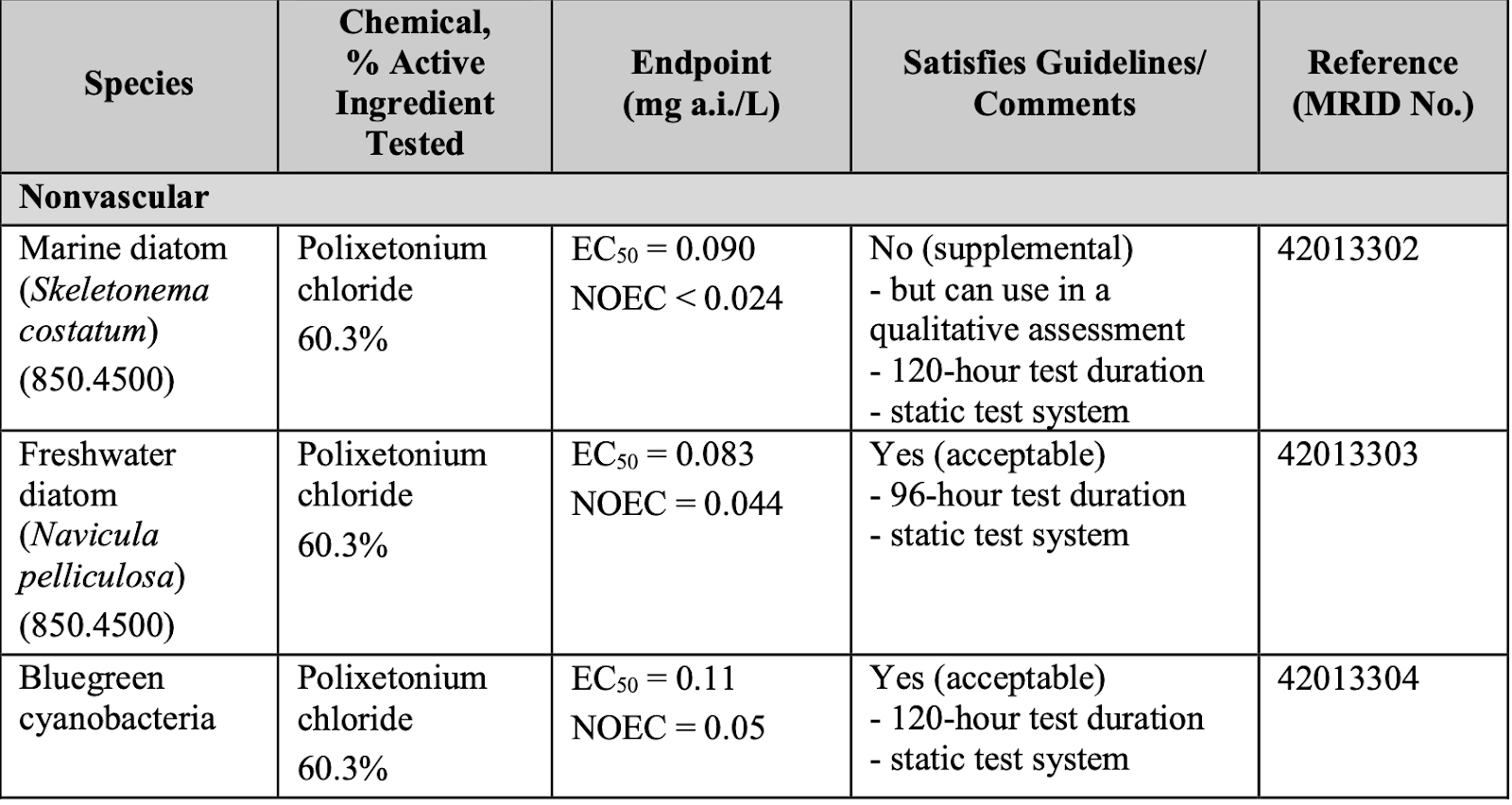
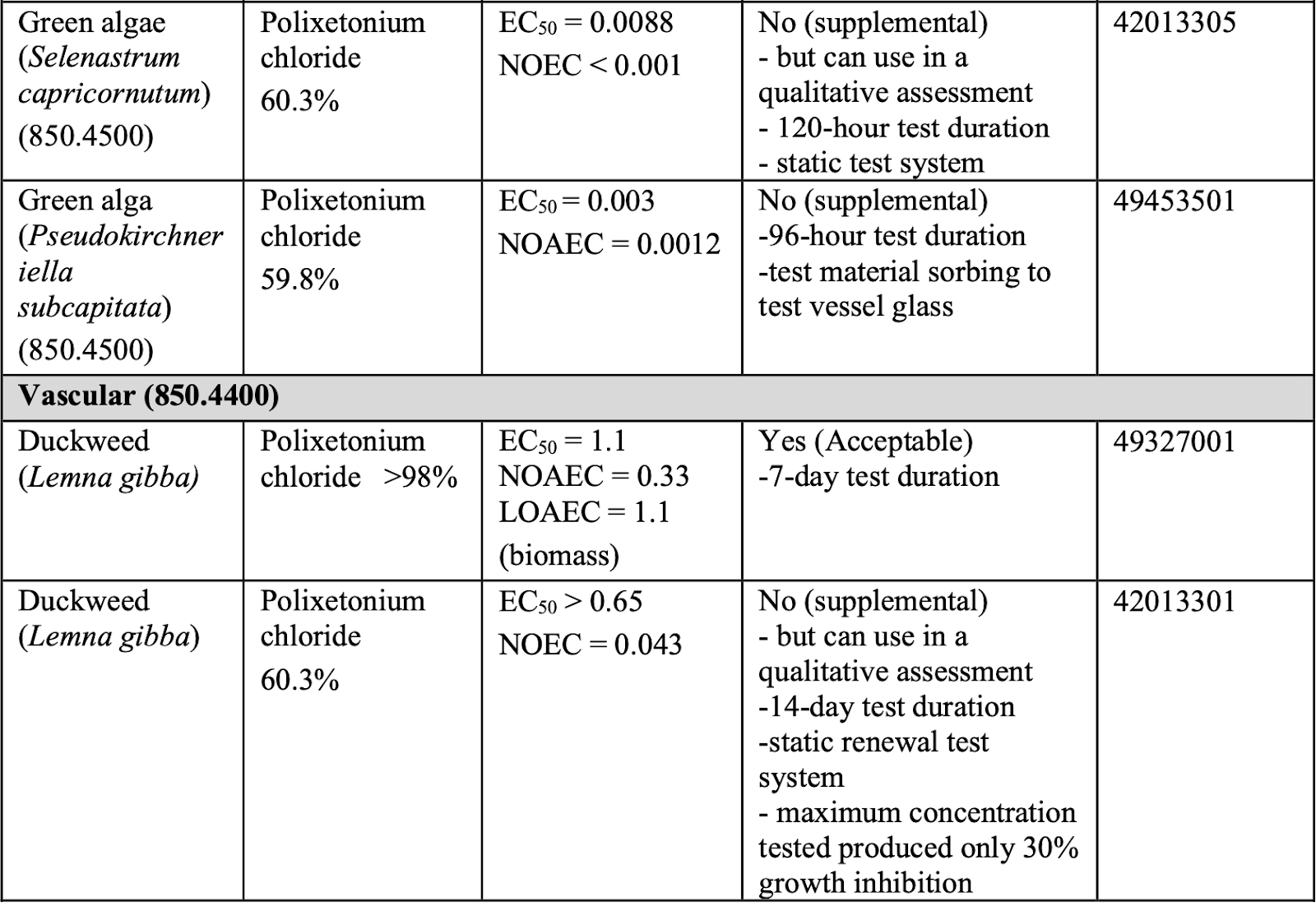
The approximate concentrations for each group are: diatoms and cyano at ~0.1ppm, green algae at ~0.01ppm, and vascular plants at ~1ppm. The label dose of Algaefix results in an addition of ~1ppm per every 3 days. Perhaps unexpectedly, it does not seem to leave the system (though it would be expected to dissipate from the water).
“Polixetonium chloride is miscible in water [study #’s…] and is not expected to degrade by either abiotic processes [...] or biotic processes [...] Sorption to soil, sediment, and sludge is expected to be the primary route of dissipation, based on the fact that polixetonium chloride is a quaternary ammonium compound that has a positive electrical charge.
A ready biodegradability study […] demonstrated stability to microbial degradation in a WWTP [wastewater treatment plant], which is consistent with the results of other non-WWTP microbial degradation. Therefore, for polixetonium chloride, there is no apparent route of chemical or microbial degradation.”
One final note on known properties and uses of polixetonium chloride is that this same chemical(nih.gov) under the name Bubond 60 is also used as a coagulant / flocculant. This helps shed light on reports of increased water clarity with aquarium usage of the product.
A paper shared by @jeffww illustrated the use of a distinctive Bromphenol Blue color response (non-pH) to detect quats dried on surfaces. I noted a quat-like color change with both Algaefix and Vibrant, but in none of almost a dozen bottled bacteria hobby products or saltwater. After that, a more thorough investigation of Vibrant and Algaefix properties was undertaken. Below is the first part of those results.
Part 1: Professional Lab Tests indicate indistinguishable principle ingredients in Vibrant and Algaefix - polixetonium chloride
Samples of Algaefix and Vibrant were poured from the product bottles into labeled 50mL centrifuge tubes and shipped to a lab for NMR testing. 1mL of each was vacuum-dried and the residue taken up in heavy water for analysis by 13C and 1H NMR. A separate partially-used bottle of Vibrant was sent to @jeffww for FTIR comparison to Algaefix in another lab. Those samples were also dried under vacuum for FTIR analysis.
A) 13C NMR
This is a test that generates a magnetic resonance response from Carbon atoms in the sample. The resonance refers to the frequency at which certain carbon atoms will oscillate when pushed around by magnetic fields. Their preferred frequency depends on their local environment - that is, what they are bonded to. Thus a 13C NMR is a probe of the chemical structure of the compounds, with each Carbon atom in the compound being shifted to a different place in the graph by what it is bonded to. More thorough intro for 13C NMR in this text, and a follow-up.
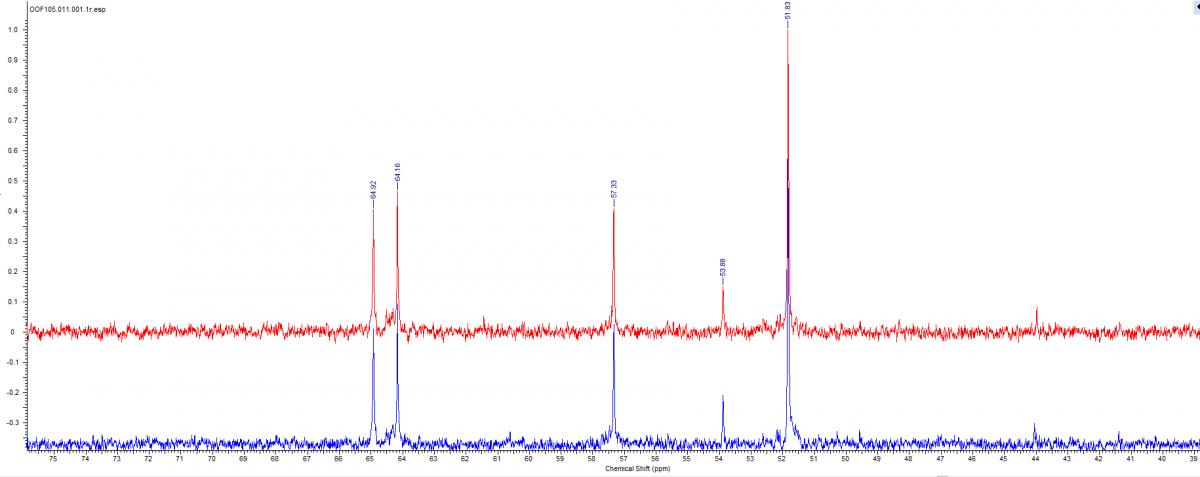
In the above graph you can see that the samples of Algaefix and Vibrant possess only Carbon in the same bond environments as each other, and the Carbon atoms are in those environments in the same ratios.
A wider view shows the blank around 170 ppm chemical shift where aspartic acid (and any other amino acid) would have a peak, if there were any in the samples.
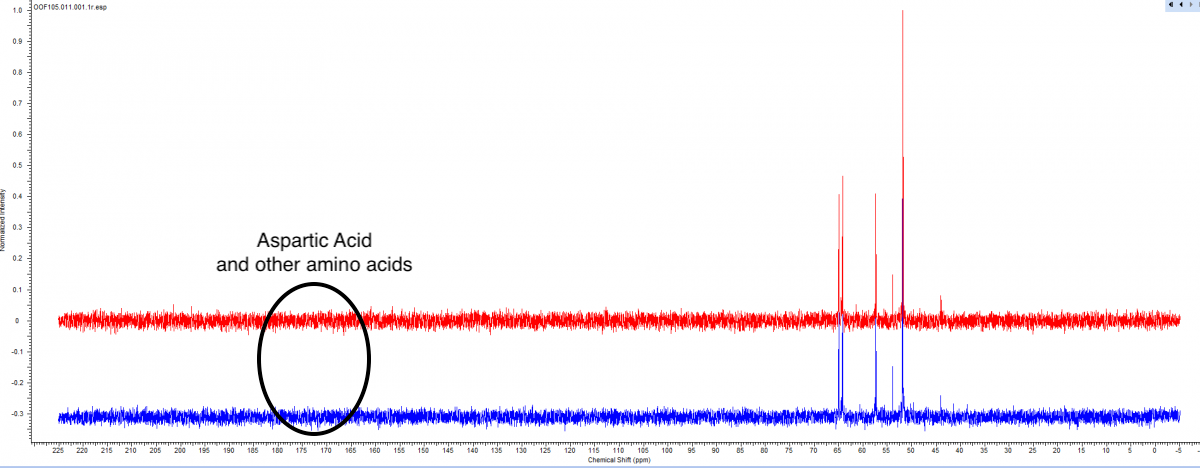
B) 1H NMR
This is the same process described above but for Hydrogen instead of Carbon. In the below data you can see that the hydrogen atoms in each sample also exist in the same bond environments and are in those particular environments in the same ratios.
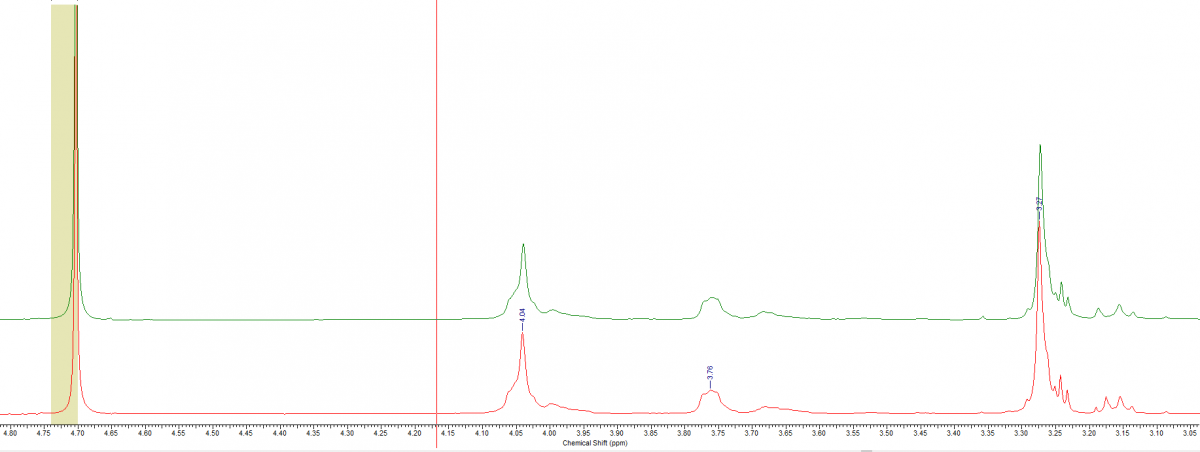
Since both the Carbon and Hydrogen atoms are bonded in the same way in these vacuum-dried samples of AlgaeFix and Vibrant, this covers all possible organics in the residue.
C) FTIR
This process generates an absorption spectrum in the infrared region where chemical compounds are distinctive in what wavelengths they absorb.
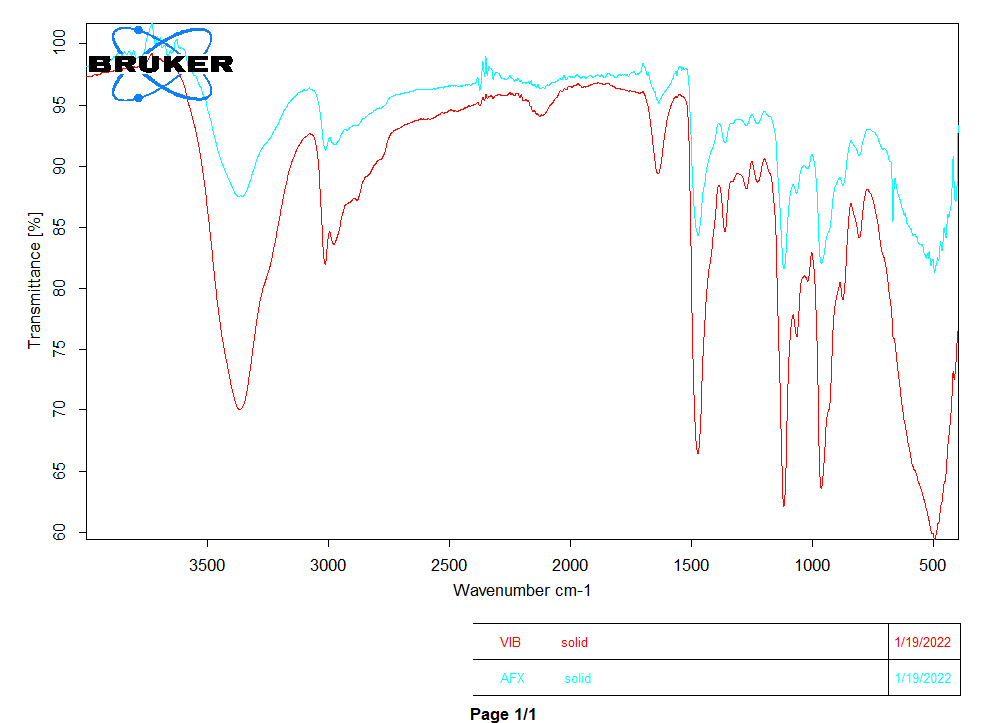
Again, the precise alignment of the absorption peaks and the consistency of their peak height ratios between the vacuum-dried samples of Algaefix and Vibrant tells us that the residues are the same compounds with no additions. (The addition of aspartic or other amino acids would be very obvious in this data as well).
In addition to being able to say that Algaefix and Vibrant contain only the same compounds in their dried residues, we can further compare that to a given FTIR spectrum for polixetonium chloride “Busan 77” (posted online).
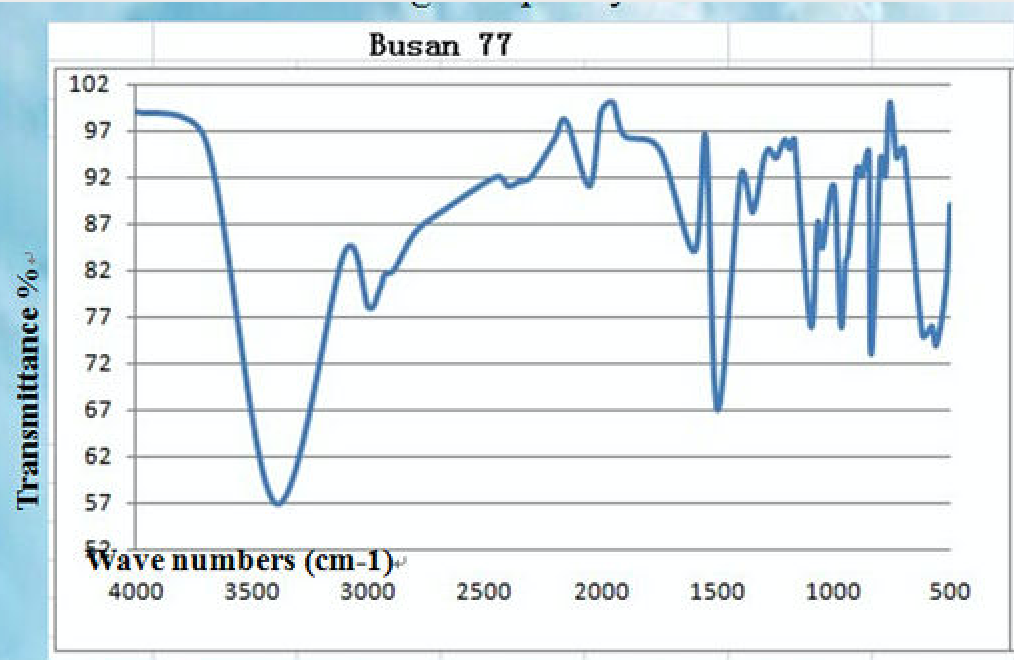
This level of agreement confirms further that what was measured by the above tests in samples of Vibrant and Algaefix is indeed the polyquat that is the well-documented label ingredient in Algaefix, polixetonium chloride.
next...
Part 2: quantification / comparison of the amount of polyquat in Vibrant and Algaefix
edit: 2/28/22
Part 2: post 16 here
Part 3: post 165 here
UWC response 2/28
edit: 3/10/22 & 3/15/22
Sample NMR test replication was done by @jda (so different hobbyist, different bottle from a different source, sent to a different lab with different technicians.) Results (1H NMR) he received are in post 731 here and (13C NMR) in post 778 here.
Overlays of the data I received and what jda received are below.
1H NMR

(same peaks shifted by the calibration difference between instruments)
and 13C

Background on Algaefix / polixetonium chloride
Algaefix by API contains 4.5% “dimethyliminoethylene dichloride, ethoxylate” CAS 31512-74-0 per MSDS and EPA documentation. This amount is the same in the various Algaefix Marine, Pond, etc labels. This chemical is a polymeric quaternary ammonium compound. Other quaternary ammonium compounds or “quats” (not polymers), such as benzalkonium chloride are in widespread use as sanitizers, antibacterial soaps etc. The Algaefix chemical is also known by the trade name Busan 77 or the more recently EPA-favored name polixetonium chloride, I will refer to it by these or simply “the polyquat.”
Polixetonium chloride is a well-known algaecide, registered in the U.S. since 1971. The EPA documentation on it is thorough and has a number of useful bits of info. This 65 page EPA draft risk assessment from 2020 covers most relevant info, including the material below. This chart shows the concentrations at which it was found to have an inhibitory effect on various “algae”.
The approximate concentrations for each group are: diatoms and cyano at ~0.1ppm, green algae at ~0.01ppm, and vascular plants at ~1ppm. The label dose of Algaefix results in an addition of ~1ppm per every 3 days. Perhaps unexpectedly, it does not seem to leave the system (though it would be expected to dissipate from the water).
“Polixetonium chloride is miscible in water [study #’s…] and is not expected to degrade by either abiotic processes [...] or biotic processes [...] Sorption to soil, sediment, and sludge is expected to be the primary route of dissipation, based on the fact that polixetonium chloride is a quaternary ammonium compound that has a positive electrical charge.
A ready biodegradability study […] demonstrated stability to microbial degradation in a WWTP [wastewater treatment plant], which is consistent with the results of other non-WWTP microbial degradation. Therefore, for polixetonium chloride, there is no apparent route of chemical or microbial degradation.”
One final note on known properties and uses of polixetonium chloride is that this same chemical(nih.gov) under the name Bubond 60 is also used as a coagulant / flocculant. This helps shed light on reports of increased water clarity with aquarium usage of the product.
A paper shared by @jeffww illustrated the use of a distinctive Bromphenol Blue color response (non-pH) to detect quats dried on surfaces. I noted a quat-like color change with both Algaefix and Vibrant, but in none of almost a dozen bottled bacteria hobby products or saltwater. After that, a more thorough investigation of Vibrant and Algaefix properties was undertaken. Below is the first part of those results.
Part 1: Professional Lab Tests indicate indistinguishable principle ingredients in Vibrant and Algaefix - polixetonium chloride
Samples of Algaefix and Vibrant were poured from the product bottles into labeled 50mL centrifuge tubes and shipped to a lab for NMR testing. 1mL of each was vacuum-dried and the residue taken up in heavy water for analysis by 13C and 1H NMR. A separate partially-used bottle of Vibrant was sent to @jeffww for FTIR comparison to Algaefix in another lab. Those samples were also dried under vacuum for FTIR analysis.
A) 13C NMR
This is a test that generates a magnetic resonance response from Carbon atoms in the sample. The resonance refers to the frequency at which certain carbon atoms will oscillate when pushed around by magnetic fields. Their preferred frequency depends on their local environment - that is, what they are bonded to. Thus a 13C NMR is a probe of the chemical structure of the compounds, with each Carbon atom in the compound being shifted to a different place in the graph by what it is bonded to. More thorough intro for 13C NMR in this text, and a follow-up.
In the above graph you can see that the samples of Algaefix and Vibrant possess only Carbon in the same bond environments as each other, and the Carbon atoms are in those environments in the same ratios.
A wider view shows the blank around 170 ppm chemical shift where aspartic acid (and any other amino acid) would have a peak, if there were any in the samples.
B) 1H NMR
This is the same process described above but for Hydrogen instead of Carbon. In the below data you can see that the hydrogen atoms in each sample also exist in the same bond environments and are in those particular environments in the same ratios.
Since both the Carbon and Hydrogen atoms are bonded in the same way in these vacuum-dried samples of AlgaeFix and Vibrant, this covers all possible organics in the residue.
C) FTIR
This process generates an absorption spectrum in the infrared region where chemical compounds are distinctive in what wavelengths they absorb.
Again, the precise alignment of the absorption peaks and the consistency of their peak height ratios between the vacuum-dried samples of Algaefix and Vibrant tells us that the residues are the same compounds with no additions. (The addition of aspartic or other amino acids would be very obvious in this data as well).
In addition to being able to say that Algaefix and Vibrant contain only the same compounds in their dried residues, we can further compare that to a given FTIR spectrum for polixetonium chloride “Busan 77” (posted online).
This level of agreement confirms further that what was measured by the above tests in samples of Vibrant and Algaefix is indeed the polyquat that is the well-documented label ingredient in Algaefix, polixetonium chloride.
next...
Part 2: quantification / comparison of the amount of polyquat in Vibrant and Algaefix
edit: 2/28/22
Part 2: post 16 here
Part 3: post 165 here
UWC response 2/28
edit: 3/10/22 & 3/15/22
Sample NMR test replication was done by @jda (so different hobbyist, different bottle from a different source, sent to a different lab with different technicians.) Results (1H NMR) he received are in post 731 here and (13C NMR) in post 778 here.
Overlays of the data I received and what jda received are below.
1H NMR
(same peaks shifted by the calibration difference between instruments)
and 13C
Last edited:


















